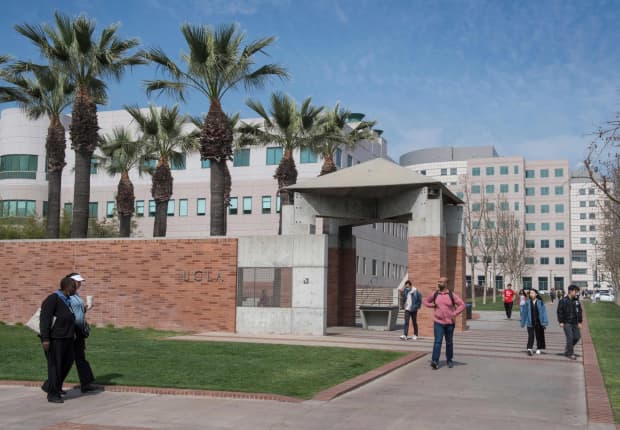
People walk through the campus of UCLA in Westwood, California in March. Colleges are preparing for fewer international students to arrive on campus this fall. (Photo by Mark RALSTON / AFP) (Photo by MARK RALSTON/AFP via Getty Images)
mark ralston/Agence France-Presse/Getty Images
The number of international students studying at U.S. universities this fall is likely to drop from last year, a survey released Thursday predicts.
More than 50% of the 520 higher education institutions surveyed by the International Institute of Education said they saw a year-on-year decrease in the number of applications from international students for the upcoming academic year. Roughly 18% of institutions said they saw a “substantial decline” in applications, it added.
So far, 57,855 international students have accepted enrollment for fall 2020 at 286 U.S. colleges and universities that provided that data to IIE. Another 4,488 deferred their enrollment to the spring semester or later.
IIE doesn’t have comparable data for international student enrollment levels for this time last year, but there’s reason to believe that fewer international students will make it to campus this fall. The majority of the 343 international education professionals working at U.S. colleges and universities surveyed by World Education Services in April said they expect international student enrollment to decline at their schools this upcoming year.
“It’s a perfect storm of issues that are confronting new international students and colleges,” said Miriam Feldblum, the executive director of The President’s Alliance on Higher Education and Immigration, a coalition of university officials focused on immigration policies’ impact on higher education.
Any decline in the number of students coming from abroad to the U.S. for education could have implications for colleges’ finances, which have already been squeezed by the pandemic. Research indicates that public colleges rely on international students, who typically pay full tuition, to fill in budget gaps.
A drop in international students would also likely impact the economy more broadly; international students contributed $45 billion to the economy in 2018, according to IIE.
Policies and travel restrictions make enrolling in the U.S. difficult
Those issues include: travel restrictions imposed as a result of the pandemic as well as delays in processing visas due to pandemic-related limitations on interviews. “The government then laid on top of that additional policy decisions that further discouraged new international students from being able to enter the U.S.,” Feldblum said.
U.S. Immigration and Customs Enforcement, or ICE, issued guidance in early July indicating that continuing international students wouldn’t be able to remain in the U.S. if they took their courses online. After pushback, ICE rescinded that guidance a week later. On Friday, the agency issued guidelines on new international students indicating that they could not come to the U.S. for fully remote instruction.
These restrictions came amid broader “insecurity” that a “series of policy attempts and policy measures have created for international students and scholars,” over the past few years, Feldblum said.
Since the Trump administration took office, efforts like the ban on travelers entering the U.S. from some countries; temporarily freezing categories of certain work visas; and limiting the entry of certain students and scholars into the U.S. from China have had a chilling effect on the environment for international students over the past few years.
Half of the 921 prospective international students surveyed by WES said they expect the pandemic to negatively impact the openness of U.S. society to international students.
Even as uncertainty remains surrounding how many new international students will be able to make it to the U.S. for school this fall, colleges are likely preparing hybrid education plans in part so that they can bring new international students to the U.S., Feldblum said. Indeed, 87% of the colleges surveyed by IIE said they were planning for a mix of in-person and online instruction.
“There’s so much unknown and so much planning that has to take place regardless,” she said.